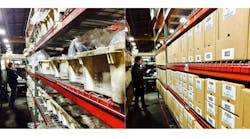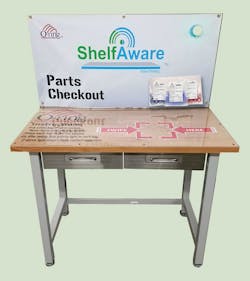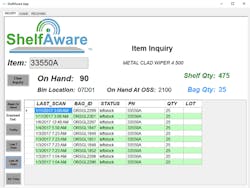This file type includes high-resolution graphics and schematics when applicable.
No matter where you fit into the fluid power supply chain, keeping close tabs on inventory is essential for efficient operations. Many original equipment manufacturers (OEMs) struggle to effectively manage their purchased inventory. The challenges are numerous: tracking physical on-hand values, maintaining an organized and space-efficient stock, keeping inventory fresh and lean, all while not running out of parts. Running out of stock of any part can hold up a multimillion-dollar project, but it seems even more painful when the missing part costs only a few cents.
Historically, these challenges have been outsourced to place the burden on the vendors by using a vendor-managed inventory (VMI) system. Two predominant methods of VMI are used in industrial distribution today. One has not changed in decades and involves vendors periodically sending employees on-site to monitor bins and record replenishment needs. The expense to vendors for this type of system is considerable, leaving them in a difficult position to be price-competitive. Vendors typically build the increased labor, travel, and other overhead costs into the price of the items being sold.
The other common method is a slight upgrade over traditional systems. By using technology options—such as barcode scanners, weigh nodes, and additional processes—vendors attempt to push the daily inventory tracking back to the OEM. This greatly reduces the costs to the vendor, but requires a big commitment from the OEM’s staff. The benefits of the tech add-ons—primarily efficiency—are quickly outweighed by the many shortcomings of the now-complicated system. Therefore, OEMs struggle to get factory line workers on board with these complex rules, dooming the system from day one.
A Search for Something Better
We faced these same issues at O-ring Sales & Service, a 35-year-old distributor of seals and gaskets. It became our mission to create an inventory tracking system that could be run remotely without complicated processes or rules. We started by looking to a growing technology trend, the Industrial Internet of Things (IIoT). The IIoT is a development of the internet that gives network connectivity to manufacturing equipment and processes.
The concept was already familiar. We had already embraced the IIoT for our own operation, developing a smart counting scale and mobile app to further automate our shipping process. The IIoT presented new opportunities in inventory management using the latest technology to make our inventory intelligent.
In our case, the intelligent inventory is consumables: O-rings and a wide range of other sealing products, such as engineered plastics and custom-molded rubber. The key concept was how to make the consumable inventory smart, thereby allowing us to remotely collect endless data points that drive automated analytics for each inventory item.
This led to another key concept that builds the foundation for intelligent inventory management—Big Data. Big Data is the collection of extremely large data sets that can be analyzed computationally to reveal patterns, trends, and associations. As we collect Big Data on each inventory item, we apply a host of inventory analytics that were developed in-house over the last several years to automate the replenishment of our own supply chain.
How It’s Going
We launched our patent-pending ShelfAware inventory management system after more than two years of development. ShelfAware is built on a solid foundation of the IIoT, Big Data, and automated analytics to make inventory intelligent. OEMs of any size, from any industry, located anywhere in the world, can now leverage their purchased inventory. Because of the IIoT, geography and physical locations no longer need to be considered when selecting a vendor to run a managed inventory system. All ShelfAware requires is a single power outlet and access to the internet.
ShelfAware easily installs in just one day and requires little integration into the OEM’s IT systems. The daily processes required by the OEM to run ShelfAware are minimal by design. Production workers simply walk in, pick what they need, swipe it over the checkout station, and go back to work.
We compare the process to Amazon’s GO retail platform. With a pilot store recently launched in Seattle, Amazon caused a stir with its autonomous grocery-store concept for the retail marketplace. ShelfAware uses similar technology to deploy an industrial convenience store on the factory floor.
The fundamental function of ShelfAware captures Big Data points for all purchased inventory and adds them to the ShelfAware App, which is installed on the OEM’s factory work terminals and PCs. With this app, the OEM gains full supply-chain visibility to any ShelfAware inventory item. The app allows users to see what components are on their storeroom shelves, as well as the quantities on the distributor’s shelves and quantities in the factory pipeline.
This high visibility of supply-chain availability takes the guesswork out of OEM’s Sales and Operations Planning (SOP). The data collected at the item level by ShelfAware is a key metric for every aspect of an OEM’s SOP activities, including sales, marketing, production planning, operations, purchasing, and finance.
ShelfAware, a concept that started as a challenge in a sales meeting, is now the beginning of our company’s never-ending quest for a perfect inventory system. It is also a fundamental element of the coming revolution toward smart factories—a movement toward automation and data exchange in manufacturing environments.
Impact on the Future
The last several years of stagnation in U.S. manufacturing have made it painfully clear that we must adapt to this new global marketplace. The advantage we have in the U.S. is technology. We have concentrated on the performance of our products for the past few decades. Now, with the IIoT, we need to concentrate on the performance of our factories.
Often overlooked business-practice advances—like a paperless office, cloud computing, and decision-level analytics—can save companies huge amounts of overhead expense, resulting in big improvements to the bottom line. For us, a smart factory starts with intelligent inventory, allowing us to leverage data to automate all aspects of every OEM’s SOP process. This creates broad efficiencies that are felt from the front office to the dock door.
Andrew Johnson is with O-ring Sales & Service Inc., Lenexa, Kansas. For more information about ShelfAware, email him at [email protected], call (913) 310-0001, or visit www.ShelfAwareVMI.com.






